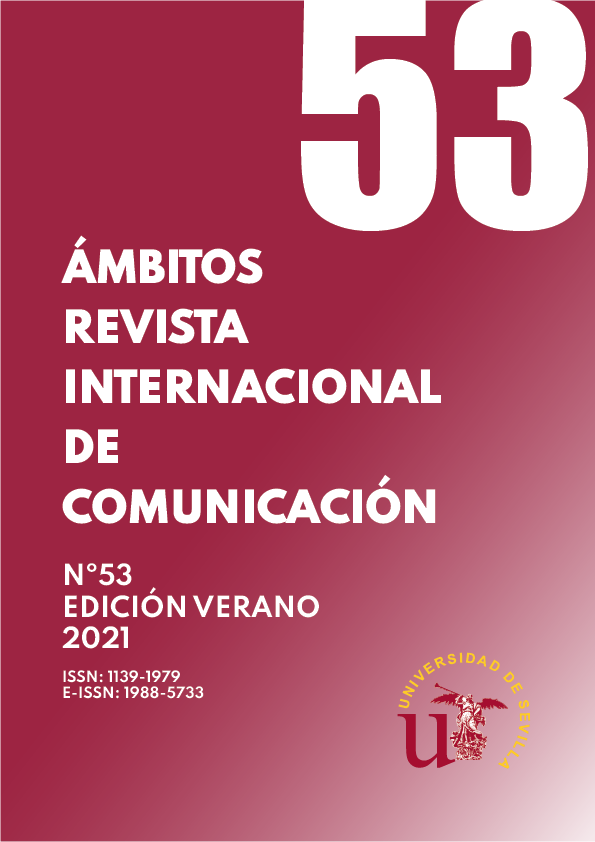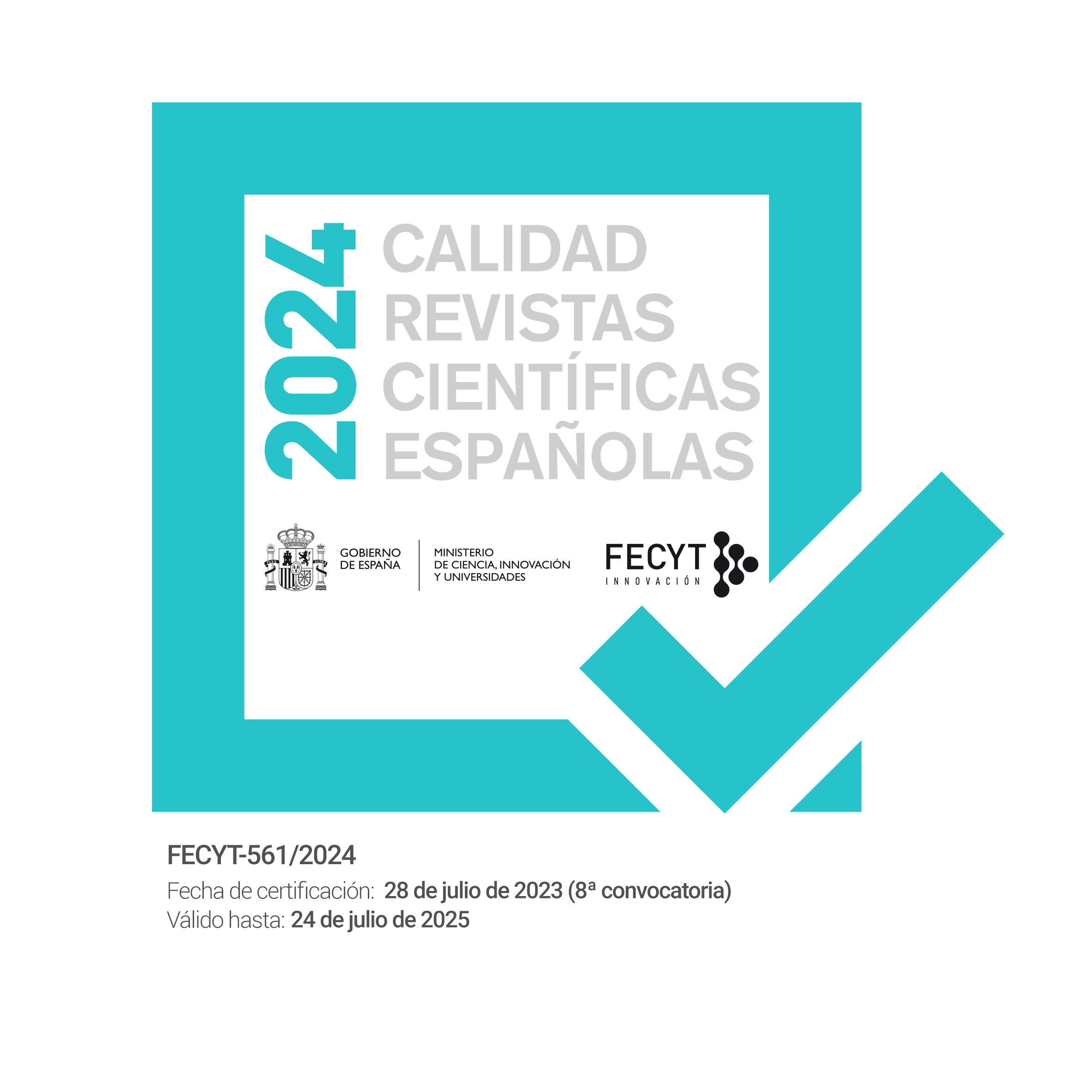Medios de comunicación como agentes activos del conflicto: el caso de la Covid-19
DOI:
https://doi.org/10.12795/Ambitos.2021.i53.07Palabras clave:
Cobertura mediática Covid-19, Prensa digital, Framing, Riesgo, Conflicto socialResumen
La situación en la que se enmarca la actualidad está altamente condicionada por los efectos de la Covid-19. Debido a las consecuencias acarreadas por la epidemia y siendo los medios de comunicación masivos las entidades con mayor capacidad de difusión, la investigación que aquí se presenta se centra en analizar la cobertura mediática de las noticias relacionadas con la Covid-19. Para ello, se han escogido los diarios más leídos en la ciudad de Barcelona en la semana del 8 al 14 de febrero del 2020. El análisis pretende observar de manera sistemática, si estas notas de prensa han hecho un uso excesivo del miedo, la alarma o el belicismo como ya indican investigaciones previas, lo cual, derivaría en un fomento de la conflictividad entre los diferentes agentes sociales. Para ello, se ha utilizado la teoría del framing y así averiguar cómo se encuadra la muestra de noticias. Además, se ha utilizado el programa Atlas.ti para realizar un análisis cualitativo, obteniendo las nubes de palabras con mayor frecuencia de uso, así como las redes entre códigos pertenecientes a una misma categoría y su conexión con códigos concurrentes. Tras el análisis se muestran diferentes resultados. Por una parte, el frame “conflicto” es el menos utilizado, y por otra, si exclusivamente atendemos a ese encuadre en concreto, sí se observa un alto uso de recursos narrativos basados en la alarma, el miedo y la guerra, pudiendo generar éstos un aumento de la percepción de conflictividad en sus lectores, movilizándose en función de esta conflictividad.
Descargas
Citas
Ajuntament de Barcelona. (2019). Enquesta de serveis municipals 2019. https://w10.bcn.cat/APPS/riswestudis/documentacio.do?reqCode=mostrarImatge&idDoc=10787
Altheide, D. L. (2002). Creating fear: News and the construction of crisis. Transaction Publishers.
Anguera, M. T., Blanco-Villaseñor, A., Losada, J. L., Sanchez-Algarra, P. & Onwuegbuzie, A. J. (2018). Revisiting the difference between mixed methods and multimethods: Is it all in the name? Quality & Quantity, 52 (6), 2757-2770. https://doi.org/10.1007/s11135-018-0700-2
Anguera, M. T., Portell, M., Chac’on-Moscoso, S. & Sanduvete-Chaves, S. (2018). Indirect observation in everyday context: Concepts and methodological guidelines within a mixed methods framework. Frontiers in Psychology, 9 (13). https://doi.org/10.3389/fpsyg.2018.00013
Ardèvol-Abreu, A. (2015). Framing o teoría del encuadre en comunicación. orígenes, desarrollo y panorama actual en España. Revista latina de comunicación social, (70), 423-450. https://doi.org/10.4185/RLCS-2015-1053
Argiñano, J. L., & Bilbao, U. G. (2020). Análisis de los titulares y las fotografías de portada en España en el contexto de la crisis del coronavirus: protagonistas, frames y lenguaje bélico. Revista de Comunicación y Salud, 10(2), 1-23. https://doi.org/10.35669/rcys.2020.10(2).1-23
Beck, U. (1998). La sociedad del riesgo: Hacia una nueva modernidad. Paidós
Boster, F. J. & Mongeau, P. (1984). Fear-arousing persuasive messages. Annals of the International communication Association, 8 (1), 330-375. https://doi.org/10.1080/23808985.1984.11678581
Busquets Duran, J. & Medina Cambrón, A. (2013). Sociologia de la comunicació. UOC.
Camacho Markina, I. (2009). Pánico infundado. Tratamiento del brote de “gripe a” en la prensa española. Actas I Congreso Internacional Latina de Comunicación Social, (64), 827-843. http://www.revistalatinacs.org/09/Sociedad/actas/19idoia.pdf
Casero-Ripollés, A. (2020). Impact of covid-19 on the media system. communicative and democratic consequences of news consumption during the outbreak. El profesional de la información, 29 (2). https://doi.org/10.3145/epi.2020.mar.23
Chomsky, N. & Herman, E. (1990). Los guardianes de la libertad. Grijalbo.
Costa-Sánchez, C. & Lopez-García, X. (2020). Comunicación y crisis del coronavirus en España. primeras lecciones. El profesional de la información (EPI), 29 (3). https://doi.org/10.3145/epi.2020.may.04
Council, N. R. (1989). Improving risk communication. https://doi.org/10.17226/1189
De Vreese, C. H. (2004). The effects of strategic news on political cynicism, issue evaluations, and policy support: A two-wave experiment. Mass Communication & Society, 7 (2), 191-214. https://doi.org/10.1207/s15327825mcs0702_4
De Vreese, C. H. (2005). News framing: Theory and typology. Information design journal & document design, 13 (1). https://doi.org/10.1075/idjdd.13.1.06vre
De Vreese, C. H., Peter, J. & Semetko, H. (2001). Framing politics at the launch of the euro: A cross-national comparative study of frames in the news. Political communication, 18 (2), 107-122. https://doi.org/10.1080/105846001750322934
Entman, R. M. (1993). Framing: Toward clarification of a fractured paradigm. Journal of Communication, 43 (4), 51-58. https://doi.org/10.1111/j.1460-2466.1993.tb01304.x
García Perdomo, V. M. & Guti’errez Coba, L. M. (2011). Manual de géneros periodísticos (2.a ed.). Universidad de la Sabana. http://hdl.handle.net/10818/27786
Gil Calvo, E. (2003). El miedo es el mensaje: Riesgo, incertidumbre y medios de comunicación. Alianza.
González, R. B., y Cambra, U. C. (2015). El virus del Ébola: análisis de su comunicación de crisis en España. Opción, 31(4), 67-86.
Hallin, D., Briggs, C., Martini Briggs, C., Spinelli, H. & Sy, A. (2020). Mediatización de las epidemias: La cobertura sobre la pandemia de la gripe a (h1n1) de 2009 en argentina, estados unidos y venezuela. Comunicación y sociedad, (9), 1-24. https://doi.org/10.32870/cys.v2020.7207
Igartua, J. J., Cheng, L., Moral, F., Fernández, I., Frutos, F. J., Gómez-Isla, J. & Otero, J. A. (2008). Encuadrar la inmigración en las noticias y sus efectos socio-cognitivos. Palabra Clave, 11 (1), 87-107. https://www.redalyc.org/articulo.oa?id=64911108
Igartua, J. J., Muñiiz, C. & Cheng, L. (2005). La inmigración en la prensa española. aportaciones empíricas y metodológicas desde la teoría del encuadre noticioso. Migraciones. Publicación del Instituto Universitario de Estudios sobre Migraciones, (17), 143-181. https://revistas.comillas.edu/index.php/revistamigraciones/article/view/4220
Kasperson, R. E., Renn, O., Slovic, P., Brown, H. S., Emel, J., Goble, R., . . . Ratick, S. (1988). The social amplification of risk: A conceptual framework. Risk analysis, 8 (2), 177-187. https://doi.org/10.1111/j.1539-6924.1988.tb01168.x
Lewison, G. (2008). The reporting of the risk from severe acute respiratory syndrome (sars) in the news media, 2003-2004. Health, risk and society, 10 (3), 241-262. https://doi.org/10.1080/13698570802160962
Lorente, J.-I. (2010). H1n1. virus, discurso del riesgo y gestión mediática de la alarma sanitaria. Comunicación y desarrollo en la era digital. II Congreso Internacional de la Asociación Española de Investigadores de la Comunicación (AE-IC). http://fama2.us.es/fco/congresoaeic/37.pdf
Masip, P., Aran-Ramspott, S., Ruiz-Caballero, C., Suau, J., Almenar, E. & Puertas-Graell, D. (2020). Consumo informativo y cobertura mediática durante el confinamiento por el covid-19: Sobreinformación, sesgo ideológico y sensacionalismo. El profesional de la información (EPI), 29 (3). https://doi.org/10.3145/epi.2020.may.12
Miles, M. B. & Huberman, A. M. (1994). Qualitative data analysis: An expanded sourcebook (2.a ed.) S. Publications. https://vivauniversity.files.wordpress.com/2013/11/milesandhuberman1994.pdf
Monjas Eleta, M. & Gil-Torres, A. (2017). Comunicación institucional y tratamiento periodístico de la crisis del Ébola en España entre el 6 y el 8 de octubre de 2014. Revista de Comunicación, 16 (1), 97-121. https://doi.org/10.26441/RC16.1-2017-A5
Muñiz Muriel, C. (2007). Encuadres noticiosos e inmigración: Del análisis de los contenidos al estudio de los efectos mediáticos (Tesis doctoral, Universidad de Salamanca)
Organización Mundial de la Salud (OMS). (2018). Comunicación de riesgos en emergencias de salud pública: directrices de la OMS sobre políticas y prácticas para la comunicación de riesgos en emergencias (CRE)
Quarantelli, E. L. (2002). The role of the mass communication system in natural and technological disasters and possible extrapolation to terrorism situations. Risk Management, 4 (4), 7-21. https://doi.org/10.1057/palgrave.rm.8240130
Rey, G. & Rincón, O. (2008). Los cuentos mediáticos del miedo. Urvio. Revista Latino-americana de Seguridad Ciudadana, (5), 34-45. https://doi.org/10.17141/urvio.5.2008.1093
Rodríguez-Andrés, R. (2011). La efectividad del uso del miedo como factor persuasivo en la comunicación de riesgos en las crisis sanitarias. Revista de Comunicación y Salud, 1 (2), 33-46. https://doi.org/10.35669/revistadecomunicacionysalud.2011.1(2).33-46
Sabucedo, J. M., Alzate, M. & Hur, D. (2020). Covid-19 and the metaphor of war (covid19 y la metáfora de la guerra). International Journal of Social Psychology, 4-6. https://doi.org/10.1080/02134748.2020.1783840
Sandman, P. (1994). Mass media and environmental risk: Seven principles. RISK: Health, safety and environment, 5 (3), 251-260. https://scholars.unh.edu/cgi/viewcontent.cgi?article=1198&context=risk
Semetko, H. A. & Valkenburg, P. M. (2000). Framing european politics: A content analysis of press and television news. Journal of communication, 50 (2), 93-109. https://doi.org/10.1111/j.1460-2466.2000.tb02843.x
Shih, T., Wijaya, R. & Brossard, D. (2008). Media coverage of public health epidemics: Linking framing and issue attention cycle toward an integrated theory of print news coverage of epidemics. Mass Communication and Society, 11 (2), 141-160. https://doi.org/10.1080/15205430701668121
Salván, E. J., y Jurado, M. (2015). Los errores de comunicación en la crisis del Ébola. Cuadernos de periodistas, 90 (29), 90-99
Stiff, J. B. & Mongeau, P. A. (2003). Persuasive communication (2.a ed.). The Guilford Press.
Tausczik, Y., Faasse, K., Pennebaker, J. W. & Petrie, K. J. (2012). Public anxiety and information seeking following the h1n1 outbreak: Blogs, newspaper articles, and wikipedia visits. Health communication, 27 (2), 179-185. https://doi.org/10.1080/10410236.2011.571759
Towers, S., Afzal, S., Bernal, G., Bliss, N., Brown, S., Espinoza, B., Jackson, J., Judson-Garcia, J., Khan, M., Lin, M., Mamada, R., Moreno, V., Nazari, F., Okuneye, K., Ross, M., Rodriguez, C., Medlock, J., Ebert, David., y Castillo-Chavez, C. (2015). Mass media and the contagion of fear: The case of Ébola in america. PLOS one, 10 (6). https://doi.org/10.1371/journal.pone.0129179
Westlund, O. & Ghersetti, M. (2015). Modelling news media use: Positing and applying the gc/mc model to the analysis of media use in everyday life and crisis situations. Journalism studies, 16 (2), 133-151. https://doi.org/10.1080/1461670X.2013.868139
Wolton, D. (2004). La otra mundialización: Los desafíos de la cohabitación cultural global. Gedisa
Descargas
Publicado
Cómo citar
Número
Sección
Licencia
Derechos de autor 2021 Diana Gómez Martínez, Ángela A. Castrechini Trotta

Esta obra está bajo una licencia internacional Creative Commons Atribución-NoComercial-CompartirIgual 4.0.
Ámbitos. Revista Internacional de Comunicación es una revista de acceso abierto, lo que significa que todo su contenido está disponible gratuitamente para el usuario o su institución. Los usuarios pueden leer, descargar, copiar, distribuir, imprimir, buscar o enlazar con el texto completo de los artículos, o utilizarlos para cualquier otro fin lícito, sin solicitar permiso previo al editor o al autor. Esta definición de acceso abierto se ajusta a la Iniciativa de Acceso Abierto de Budapest (BOAI).

A menos que se indique lo contrario, todo el contenido de la edición electrónica se distribuye bajo una " licencia internacional Creative Commons Attribution-NonCommercial-ShareAlike 4.0 ". Puede consultar la versión informativa y el texto legal de la licencia aquí. Esto debe indicarse expresamente de esta manera cuando sea necesario.
En caso de aceptación del manuscrito, los autores ceden los derechos de la obra para su publicación a Ámbitos. Revista Internacional de Comunicación bajo el contrato de licencia Reconocimiento-NoComercial-CompartirIgual 4.0 Internacional (CC BY-NC-SA 4.0). Los autores conservan los derechos de autor y terceros están autorizados a copiar, distribuir y hacer uso de la obra, siempre que cumplan con los términos y condiciones establecidos en la licencia.
- Citar la autoría y la fuente original de publicación (revista, editorial y URL de la obra).
- No los utilice con fines comerciales.
- Si remezcla, transforma o crea a partir del material, debe publicar sus contribuciones bajo la misma licencia que el original.
Se puede encontrar más información en https://creativecommons.org/licenses/by-nc-sa/4.0/deed.es



















